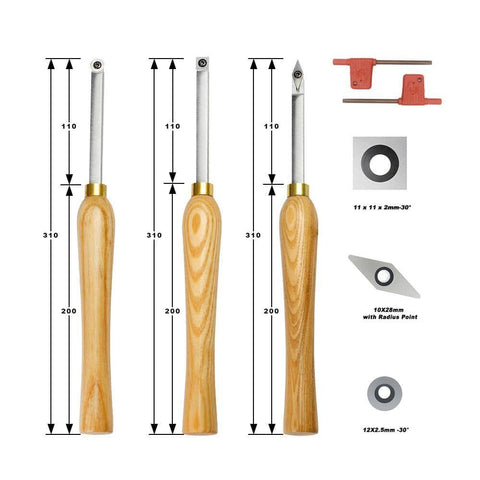 |
|
Using a lathe opens up a world of woodworking possibilities, from turning spindles and bowls to creating intricate shapes and custom designs. If you're eager to dive into woodturning but aren't sure where to start, knowing the essential tools and equipment will set you on the right path. Getting familiar with a few basics can help you begin safely, confidently, and with the right tools to make your projects successful from the start. Here's what you need to get started using a lathe and why each tool is important. |
|
|
First and foremost, the lathe itself is the centerpiece of your setup. Lathes come in various types and sizes, from mini-lathes suitable for pens and small items to larger, more robust models for turning big bowls or furniture legs. The lathe you choose will depend on the scale of the projects you want to tackle. Mini-lathes are perfect for beginners because they're less expensive and take up less space, allowing you to learn the basics without a major investment. For larger projects, a midi or full-sized lathe with more horsepower and a wider bed will offer better stability and support. As you consider different lathe options, look for one with adjustable speeds, as this feature gives you greater control over the cutting process, particularly with more intricate pieces. |
|
|
In addition to the lathe itself, you'll need a reliable set of chisels, also known as turning tools. The basic turning tool kit typically includes roughing gouges, spindle gouges, bowl gouges, skew chisels, and parting tools. Each chisel has a specific purpose and is designed for certain cuts and shapes. A roughing gouge, for instance, helps shape raw, square stock into a round form, while a bowl gouge is made for hollowing out bowls and curved pieces. Skew chisels are used to create fine, smooth finishes, and parting tools help separate or cut grooves. For a beginner, a basic set of high-speed steel (HSS) tools is usually affordable, durable, and easy to sharpen, making it ideal for learning the fundamentals. |
|
|
Safety equipment is also essential. Because Woodturing produces flying chips, dust, and sometimes larger fragments, you'll need proper protection to work safely. A full-face shield is highly recommended as it provides better coverage than goggles and shields your entire face from flying debris. A dust mask or respirator is crucial as well, especially if you'll be turning hardwoods or spending long periods at the lathe. Some woods, like walnut or mahogany, produce dust that can irritate the lungs, so respiratory protection is key. Hearing protection can also be helpful if you'll be running the lathe and other power tools for extended periods. This simple equipment ensures that you can work comfortably and safely. |
|
|
A tool rest, an adjustable arm on the lathe, is another essential part of the setup, and it helps support the chisels as they engage with the wood. The tool rest can be positioned close to the workpiece, allowing for better control and reducing strain on your hands and wrists. Adjusting it correctly is vital for effective turning, as the height and distance from the wood will affect the stability and precision of your cuts. Most lathes come with an adjustable tool rest, but having additional tool rests in various lengths and shapes can be helpful if you plan to tackle a wide range of projects. |
|
|
Another vital component of the woodturning setup is a four-jaw chuck, which securely holds the wood in place on the lathe. Unlike traditional spindle turning, where the workpiece is held between centers, a chuck provides a secure grip on bowl blanks and other larger pieces. A good chuck reduces vibration and allows you to turn more complex shapes with confidence, whether you're hollowing out a bowl or creating a decorative platter. Having a quality chuck with compatible jaws for different sizes and shapes will give you greater versatility in your projects. |
|
|
Along with the lathe, tools, and safety gear, a sharpening system is crucial for maintaining your chisels. Sharp tools are essential for clean, precise cuts and a safe working environment, as dull tools are more likely to catch or slip. A bench grinder with a low-speed motor and dedicated sharpening jigs is ideal for beginners, as it makes the sharpening process straightforward and consistent. Some woodturners use a wet stone or honing wheel to maintain an even sharper edge on their chisels, particularly for fine detail work. Regularly sharpening your tools will improve your turning results and help you develop good habits as you progress in your skills. |
|
|
Lastly, you'll want to consider a few auxiliary tools that make woodturning easier and more enjoyable. Calipers are essential for measuring the thickness and diameter of turned pieces, ensuring accuracy, especially when working with symmetrical designs or sets. Sanding materials, such as abrasive pads or sandpaper in various grits, help finish the piece to a smooth texture, and a quality wood finish - like wax, oil, or polyurethane - adds the final polish and protects the wood. A steady rest or tailstock support can also be useful, particularly for longer projects that need extra stability along the length of the piece. |
|
|
Starting with a lathe doesn't have to be overwhelming. With a basic lathe, essential chisels, safety equipment, and a few support tools, you'll be ready to begin your woodturning journey. As you gain experience, you may expand your setup with more advanced tools, but having the basics in place will allow you to learn safely and effectively. With practice, patience, and the right equipment, you'll soon discover the joy of transforming raw wood into beautiful, functional pieces on the lathe. |
|
| |
|
|





